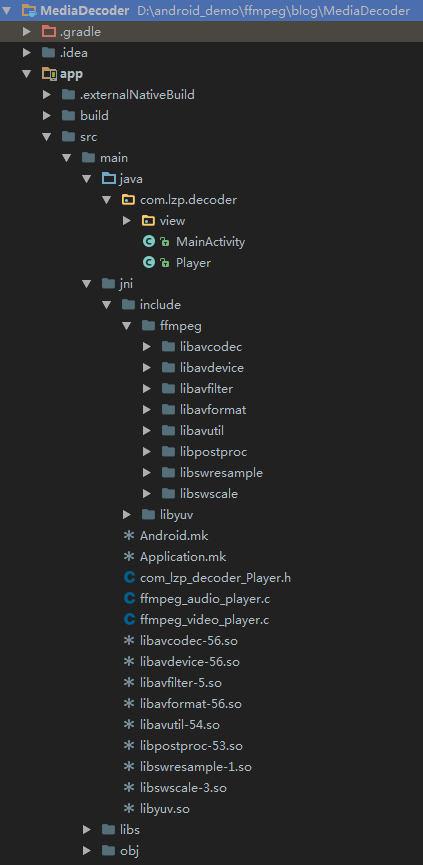FFmpeg4Android:音訊解碼與播放
阿新 • • 發佈:2019-01-27
4.3 音訊解碼
音訊解碼,就是將視訊檔案中的音訊部分抽離出來,生成PCM檔案,並使用Android控制元件AudioTrack進行播放。
新建,MedioPlayer專案,其目錄結構如下:

java端程式碼,MainActivity.java:
package com.lzp.decoder;
import java.io.File;
import com.lzp.decoder.view.VideoView;
import android.app.Activity;
import android.os.Bundle;
import android.os.Environment;
import java端程式碼,Player.java:
package com.lzp.decoder;
import android.media.AudioFormat;
import android.media.AudioManager;
import android.media.AudioTrack;
import android.util.Log;
import android.view.Surface;
/**
* 視訊播放的控制器
*/
public class Player {
// 解碼視訊
public native void render(String input, Surface surface);
// 解碼音訊
public native void sound(String input, String output);
/**
* 建立一個AudioTrac物件,用於播放
*
* @param nb_channels
* @return
*/
public AudioTrack createAudioTrack(int sampleRateInHz, int nb_channels) {
// 固定格式的音訊碼流
int audioFormat = AudioFormat.ENCODING_PCM_16BIT;
Log.i("jason", "nb_channels:" + nb_channels);
// 聲道佈局
int channelConfig;
if (nb_channels == 1) {
channelConfig = android.media.AudioFormat.CHANNEL_OUT_MONO;
} else if (nb_channels == 2) {
channelConfig = android.media.AudioFormat.CHANNEL_OUT_STEREO;
} else {
channelConfig = android.media.AudioFormat.CHANNEL_OUT_STEREO;
}
int bufferSizeInBytes = AudioTrack.getMinBufferSize(sampleRateInHz, channelConfig, audioFormat);
AudioTrack audioTrack = new AudioTrack(
AudioManager.STREAM_MUSIC,
sampleRateInHz, channelConfig,
audioFormat,
bufferSizeInBytes, AudioTrack.MODE_STREAM);
// 播放
// audioTrack.play();
// 寫入PCM
// audioTrack.write(audioData, offsetInBytes, sizeInBytes);
return audioTrack;
}
static {
System.loadLibrary("avutil-54");
System.loadLibrary("swresample-1");
System.loadLibrary("avcodec-56");
System.loadLibrary("avformat-56");
System.loadLibrary("swscale-3");
System.loadLibrary("postproc-53");
System.loadLibrary("avfilter-5");
System.loadLibrary("avdevice-56");
System.loadLibrary("myffmpeg");
}
}
c端解碼程式碼,ffmpeg_audio_player.c:
#include "com_lzp_decoder_Player.h"
#include <stdlib.h>
#include <unistd.h>
#include <android/log.h>
//封裝格式
#include "libavformat/avformat.h"
//解碼
#include "libavcodec/avcodec.h"
//縮放
#include "libswscale/swscale.h"
//重取樣
#include "libswresample/swresample.h"
#define LOGI(FORMAT, ...) __android_log_print(ANDROID_LOG_INFO, "ffmpeg",FORMAT, ##__VA_ARGS__);
#define LOGE(FORMAT, ...) __android_log_print(ANDROID_LOG_ERROR, "ffmpeg",FORMAT, ##__VA_ARGS__);
#define MAX_AUDIO_FRME_SIZE 48000 * 4
JNIEXPORT void JNICALL Java_com_lzp_decoder_Player_sound
(JNIEnv *env, jobject jthiz, jstring input_jstr, jstring output_jstr){
const char* input_cstr = (*env)->GetStringUTFChars(env, input_jstr, NULL);
const char* output_cstr = (*env)->GetStringUTFChars(env, output_jstr, NULL);
LOGI("%s", "sound");
// 註冊元件
av_register_all();
AVFormatContext *pFormatCtx = avformat_alloc_context();
//開啟音訊檔案
if (avformat_open_input(&pFormatCtx, input_cstr, NULL, NULL) != 0){
LOGI("無法開啟音訊檔案:%s\n", input_cstr);
return;
}
// 獲取輸入檔案資訊
if (avformat_find_stream_info(pFormatCtx, NULL) < 0){
LOGI("%s", "無法獲取輸入檔案資訊");
return;
}
// 獲取音訊流索引位置
int i = 0, audio_stream_idx = -1;
for (; i < pFormatCtx->nb_streams; i++){
if (pFormatCtx->streams[i]->codec->codec_type == AVMEDIA_TYPE_AUDIO){
audio_stream_idx = i;
break;
}
}
// 獲取解碼器
AVCodecContext *codecCtx = pFormatCtx->streams[audio_stream_idx]->codec;
AVCodec *codec = avcodec_find_decoder(codecCtx->codec_id);
if (codec == NULL){
LOGI("%s", "無法獲取解碼器");
return;
}
// 開啟解碼器
if (avcodec_open2(codecCtx, codec, NULL) < 0){
LOGI("%s", "無法開啟解碼器");
return;
}
// 壓縮資料
AVPacket *packet = (AVPacket *)av_malloc(sizeof(AVPacket));
// 解壓縮資料
AVFrame *frame = av_frame_alloc();
// frame->16bit 44100 PCM 統一音訊取樣格式與取樣率
SwrContext *swrCtx = swr_alloc();
// 重取樣設定引數-------------start
// 輸入的取樣格式
enum AVSampleFormat in_sample_fmt = codecCtx->sample_fmt;
// 輸出取樣格式16bit PCM
enum AVSampleFormat out_sample_fmt = AV_SAMPLE_FMT_S16;
// 輸入取樣率
int in_sample_rate = codecCtx->sample_rate;
// 輸出取樣率
int out_sample_rate = in_sample_rate;
// 獲取輸入的聲道佈局
// 根據聲道個數獲取預設的聲道佈局(2個聲道,預設立體聲stereo)
// av_get_default_channel_layout(codecCtx->channels);
uint64_t in_ch_layout = codecCtx->channel_layout;
// 輸出的聲道佈局(立體聲)
uint64_t out_ch_layout = AV_CH_LAYOUT_STEREO;
swr_alloc_set_opts(swrCtx,
out_ch_layout, out_sample_fmt, out_sample_rate,
in_ch_layout, in_sample_fmt, in_sample_rate,
0, NULL);
swr_init(swrCtx);
// 輸出的聲道個數
int out_channel_nb = av_get_channel_layout_nb_channels(out_ch_layout);
// 重取樣設定引數-------------end
// JNI begin------------------
// JasonPlayer
jclass player_class = (*env)->GetObjectClass(env, jthiz);
// AudioTrack物件
jmethodID create_audio_track_mid = (*env)->GetMethodID(env, player_class, "createAudioTrack", "(II)Landroid/media/AudioTrack;");
jobject audio_track = (*env)->CallObjectMethod(env, jthiz, create_audio_track_mid, out_sample_rate, out_channel_nb);
// 呼叫AudioTrack.play方法
jclass audio_track_class = (*env)->GetObjectClass(env, audio_track);
jmethodID audio_track_play_mid = (*env)->GetMethodID(env, audio_track_class, "play", "()V");
(*env)->CallVoidMethod(env, audio_track, audio_track_play_mid);
// AudioTrack.write
jmethodID audio_track_write_mid = (*env)->GetMethodID(env, audio_track_class, "write", "([BII)I");
// JNI end------------------
FILE *fp_pcm = fopen(output_cstr, "wb");
// 16bit 44100 PCM 資料
uint8_t *out_buffer = (uint8_t *)av_malloc(MAX_AUDIO_FRME_SIZE);
int got_frame = 0, index = 0, ret;
// 不斷讀取壓縮資料
while (av_read_frame(pFormatCtx, packet) >= 0){
// 解碼音訊型別的Packet
if (packet->stream_index == audio_stream_idx){
// 解碼
ret = avcodec_decode_audio4(codecCtx, frame, &got_frame, packet);
if (ret < 0){
LOGI("%s", "解碼完成");
}
// 解碼一幀成功
if (got_frame > 0){
LOGI("解碼:%d", index++);
swr_convert(swrCtx, &out_buffer, MAX_AUDIO_FRME_SIZE, (const uint8_t **)frame->data, frame->nb_samples);
// 獲取sample的size
int out_buffer_size = av_samples_get_buffer_size(NULL, out_channel_nb,
frame->nb_samples, out_sample_fmt, 1);
fwrite(out_buffer, 1, out_buffer_size, fp_pcm);
// out_buffer緩衝區資料,轉成byte陣列
jbyteArray audio_sample_array = (*env)->NewByteArray(env, out_buffer_size);
jbyte* sample_bytep = (*env)->GetByteArrayElements(env, audio_sample_array, NULL);
// out_buffer的資料複製到sampe_bytep
memcpy(sample_bytep, out_buffer, out_buffer_size);
// 同步
(*env)->ReleaseByteArrayElements(env, audio_sample_array, sample_bytep, 0);
// AudioTrack.write PCM資料
(*env)->CallIntMethod(env, audio_track, audio_track_write_mid,
audio_sample_array, 0, out_buffer_size);
// 釋放區域性引用
(*env)->DeleteLocalRef(env, audio_sample_array);
usleep(1000 * 16);
}
}
av_free_packet(packet);
}
av_frame_free(&frame);
av_free(out_buffer);
swr_free(&swrCtx);
avcodec_close(codecCtx);
avformat_close_input(&pFormatCtx);
(*env)->ReleaseStringUTFChars(env, input_jstr, input_cstr);
(*env)->ReleaseStringUTFChars(env, output_jstr, output_cstr);
}
執行結果日誌:

